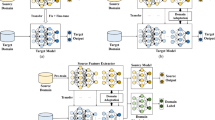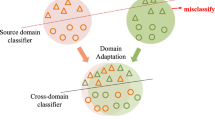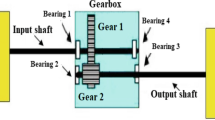Abstract
Artificial intelligence (AI), which has recently gained popularity, is being extensively employed in modern fault diagnostic research to preserve the reliability and productivity of machines. The effectiveness of AI is influenced by the quality of the labeled training data. However, in engineering scenarios, available data on mechanical equipment are scarce, and collecting massive amounts of well-annotated fault data to train AI models is expensive and difficult. In response to the inadequacy of training samples, a numerical simulation-based partial transfer learning method for machinery fault diagnosis is proposed. First, a suitable simulation model of critical components in a mechanical system is developed using the finite element method (FEM), and numerical simulation is performed to acquire FEM simulation samples containing different fault types. Second, several synthetic simulation samples are generated to form complete source domain training samples using a generative adversarial network. Subsequently, the partial transfer learning network is trained to extract shared fault characteristics between the simulation and measured samples in the case of class imbalance. Finally, the resulting model is used to diagnose unknown samples from real-world mechanical systems in operation. The proposed method is tested on actual fault samples of bearings and gears obtained from a public dataset and experimental test rig available in our laboratory, achieving average classification accuracy of 99.54% and 99.64%, respectively. Comparison investigations reveal that the proposed method has superior classification and generalization ability when detecting faults in real mechanical systems.
Similar content being viewed by others
References
Jin Y R, Qin C J, Zhang Z N, et al. A multi-scale convolutional neural network for bearing compound fault diagnosis under various noise conditions. Sci China Tech Sci, 2022, 65: 2551–2563
Zhou X, Zhou H C, He Y M, et al. Harmonic reducer in-situ fault diagnosis for industrial robots based on deep learning. Sci China Tech, 2022, 65: 2116–2126
Liu Y Q, Chen Z G, Wang K Y, et al. Surface wear evolution of traction motor bearings in vibration environment of a locomotive during operation. Sci China Tech Sci, 2022, 65: 920–931
Di Z Y, Shao H D, Xiang J W. Ensemble deep transfer learning driven by multisensor signals for the fault diagnosis of bevel-gear cross-operation conditions. Sci China Tech Sci, 2021, 64: 481–492
Huang H R, Li K, Su W S, et al. An improved empirical wavelet transform method for rolling bearing fault diagnosis. Sci China Tech Sci, 2020, 63: 2231–2240
Han Z Z, Huang Y Z, Li J, et al. A hybrid deep neural network based prediction of 300 MW coal-fired boiler combustion operation condition. Sci China Tech Sci, 2021, 64: 2300–2311
Shao H D, Li W, Cai B P, et al. Dual-threshold attention-guided GAN and limited infrared thermal images for rotating machinery fault diagnosis under speed fluctuation. IEEE Trans Ind Inf, 2023, 19: 9933–9942
Chen M Z, Shao H D, Dou H X, et al. Data augmentation and intelligent fault diagnosis of planetary gearbox using ILoFGAN under extremely limited samples. IEEE Trans Rel, 2023, 72: 1029–1037
Liu G K, Shen W M, Gao L, et al. Active label-denoising algorithm based on broad learning for annotation of machine health status. Sci China Tech Sci, 2022, 65: 2089–2104
Chao Q, Gao H H, Tao J F, et al. Adaptive decision-level fusion strategy for the fault diagnosis of axial piston pumps using multiple channels of vibration signals. Sci China Tech Sci, 2022, 65: 470–480
Chen X K, Shao H D, Xiao Y M, et al. Collaborative fault diagnosis of rotating machinery via dual adversarial guided unsupervised multidomain adaptation network. Mech Syst Signal Process, 2023, 198: 110427
Qin C J, Wu R H, Huang G Q, et al. A novel LSTM-autoencoder and enhanced transformer-based detection method for shield machine cutterhead clogging. Sci China Tech Sci, 2023, 66: 512–527
Li W X, Shang Z W, Gao M S, et al. A novel deep autoencoder and hyperparametric adaptive learning for imbalance intelligent fault diagnosis of rotating machinery. Eng Appl Artif Intell, 2021, 102: 104279
Chen Z Y, Gryllias K, Li W H. Intelligent fault diagnosis for rotary machinery using transferable convolutional neural network. IEEE Trans Ind Inf, 2019, 16: 339–349
Xiang L, Wang P H, Yang X, et al. Fault detection of wind turbine based on SCADA data analysis using CNN and LSTM with attention mechanism. Measurement, 2021, 175: 109094
Mousavi Z, Varahram S, Ettefagh M M, et al. Deep neural networks-based damage detection using vibration signals of finite element model and real intact state: An evaluation via a lab-scale offshore jacket structure. Struct Health Monit, 2021, 20: 379–405
Seventekidis P, Giagopoulos D. A combined finite element and hierarchical deep learning approach for structural health monitoring: Test on a pin-joint composite truss structure. Mech Syst Signal Process, 2021, 157: 107735
Padil K H, Bakhary N, Abdulkareem M, et al. Non-probabilistic method to consider uncertainties in frequency response function for vibration-based damage detection using artificial neural network. J Sound Vib, 2020, 467: 115069
Xiang J W, Zhong Y T. A novel personalized diagnosis methodology using numerical simulation and an intelligent method to detect faults in a shaft. Appl Sci, 2016, 6: 414
Xiang J W. Numerical simulation driving generative adversarial networks in association with the artificial intelligence diagnostic principle to detect mechanical faults (in Chinese). Sci Sin Tech, 2021, 51: 341–355
Liu X Y, Huang H Z, Xiang J W. A personalized diagnosis method to detect faults in gears using numerical simulation and extreme learning machine. Knowledge-Based Syst, 2020, 195: 105653
Goodfellow I, Pouget-Abadie J, Mirza M, et al. Generative adversarial nets. Adv Neural Inf Process Syst, 2014, 27: 2672–2680
Zhu Q X, Hou K R, Chen Z S, et al. Novel virtual sample generation using conditional GAN for developing soft sensor with small data. Eng Appl Artif Intell, 2021, 106: 104497
Pei L L, Sun Z Y, Xiao L Y, et al. Virtual generation of pavement crack images based on improved deep convolutional generative adversarial network. Eng Appl Artif Intell, 2021, 104: 104376
Shao S Y, Wang P, Yan R Q. Generative adversarial networks for data augmentation in machine fault diagnosis. Comput Industry, 2019, 106: 85–93
Luo J, Huang J Y, Li H M. A case study of conditional deep convolutional generative adversarial networks in machine fault diagnosis. J Intell Manuf, 2021, 32: 407–425
Gao Y, Liu X Y, Xiang J W. FEM simulation-based generative adversarial networks to detect bearing faults. IEEE Trans Ind Inf, 2020, 16: 4961–4971
Gao Y, Liu X Y, Huang H Z, et al. A hybrid of FEM simulations and generative adversarial networks to classify faults in rotor-bearing systems. ISA Trans, 2021, 108: 356–366
Long M S, Cao Y, Cao Z J, et al. Transferable representation learning with deep adaptation networks. IEEE Trans Pattern Anal Mach Intell, 2019, 41: 3071–3085
Pan S J, Yang Q. A survey on transfer learning. IEEE Trans Knowl Data Eng, 2009, 22: 1345–1359
Cao Z J, Long M S, Wang J M, et al. Partial transfer learning with selective adversarial networks. In: Proceedings of the IEEE Conference on Computer Vision and Pattern Recognition. Salt Lake City, 2018. 2724–2732
Zhang J, Ding Z W, Li W Q, et al. Importance weighted adversarial nets for partial domain adaptation. In: Proceedings of the IEEE Conference on Computer Vision and Pattern Recognition. Salt Lake City, 2018. 8156–8164
Li W H, Chen Z Y, He G. A novel weighted adversarial transfer network for partial domain fault diagnosis of machinery. IEEE Trans Ind Inf, 2020, 17: 1753–1762
Li X, Zhang W. Deep learning-based partial domain adaptation method on intelligent machinery fault diagnostics. IEEE Trans Ind Electron, 2020, 68: 4351–4361
Deng Y F, Huang D L, Du S C, et al. A double-layer attention based adversarial network for partial transfer learning in machinery fault diagnosis. Comput Industry, 2021, 127: 103399
Liu Z H, Lu B L, Wei H L, et al. A stacked auto-encoder based partial adversarial domain adaptation model for intelligent fault diagnosis of rotating machines. IEEE Trans Ind Inf, 2021, 17: 6798–6809
Li X, Zhang W, Ma H, et al. Partial transfer learning in machinery cross-domain fault diagnostics using class-weighted adversarial networks. Neural Networks, 2020, 129: 313–322
Moaveni S. Finite Element Analysis Theory and Application with ANSYS, 3rd ed. New Jersey: Prentice Hall, 2007
Zapico-Valle J L, Alonso-Camblor R, Gonzalez-Martinez M P, et al. A new method for finite element model updating in structural dynamics. Mech Syst Signal Process, 2010, 24: 2137–2159
Wang K F, Gou C, Duan Y J, et al. Generative adversarial networks: The state of the art and beyond. Acta Autom Sin, 2017, 43: 321–332
Grandvalet Y, Bengio Y. Semi-supervised learning by entropy minimization. Adv Neural Inf Process Syst, 2004, 17
Ganin Y, Lempitsky V. Unsupervised domain adaptation by back-propagation. 2015, arXiv: 1409.7495v2
Smith W A, Randall R B. Rolling element bearing diagnostics using the Case Western Reserve University data: A benchmark study. Mech Syst Signal Process, 2015, 64–65: 100–131
Song W L, Xiang J W, Zhong Y T. A simulation model based fault diagnosis method for bearings. J Intell Fuzzy Syst, 2018, 34: 3857–3867
Biswas S K, Milanfar P. One shot detection with laplacian object and fast matrix cosine similarity. IEEE Trans Pattern Anal Mach Intell, 2016, 38: 546–562
Kingma D P, Ba J. Adam: A method for stochastic optimization. 2017, arXiv: 1412.6980v9
Verstraete D B, Droguett E L, Meruane V, et al. Deep semi-supervised generative adversarial fault diagnostics of rolling element bearings. Struct Health Monit, 2020, 19: 390–411
Van der Maaten L, Hinton G. Visualizing data using t-SNE. J Mach Learn Res, 2008, 9: 2579–2605
Author information
Authors and Affiliations
Corresponding author
Additional information
This work was supported by the National Natural Science Foundation of China (Grant No. U1909217), the Zhejiang Natural Science Foundation of China (Grant No. LD21E050001), and the Wenzhou Major Science and Technology Innovation Project of China (Grant No. ZG2020051).
Rights and permissions
About this article
Cite this article
Lou, Y., Kumar, A. & Xiang, J. Machinery fault diagnostic method based on numerical simulation driving partial transfer learning. Sci. China Technol. Sci. 66, 3462–3474 (2023). https://doi.org/10.1007/s11431-023-2496-6
Received:
Accepted:
Published:
Issue Date:
DOI: https://doi.org/10.1007/s11431-023-2496-6




